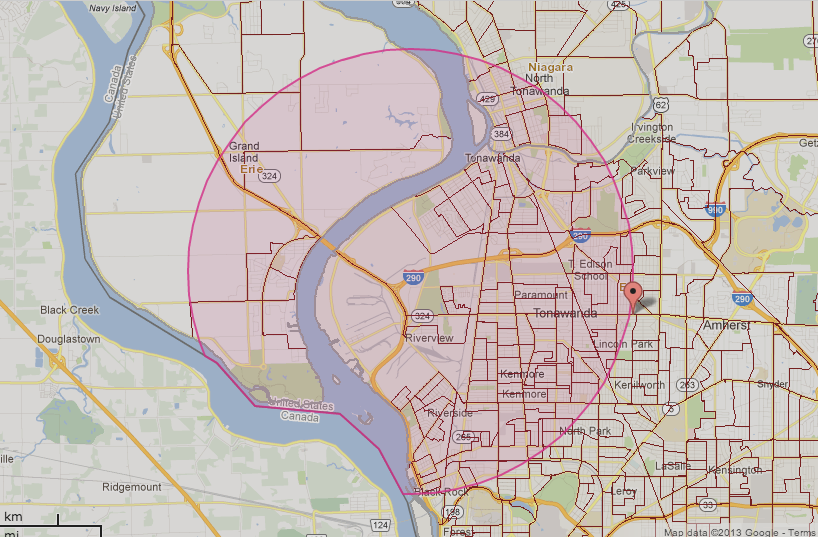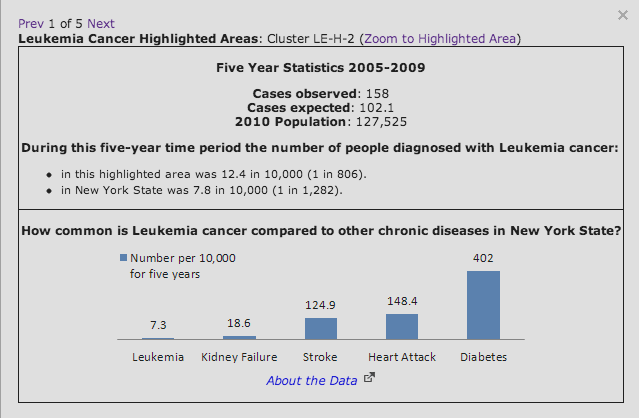Feb 28
2013
Frustration grows in toxic Tonawanda

Martin Luther King Jr. once said that of all forms of inequality, injustice in health is the most shocking and most inhumane.
I don’t have cancer or children. I moved here in September and I don’t live close to the Tonawanda industrial corridor. Until recently, I rarely ever heard of Tonawanda.
But I still felt the pain and frustration of the approximately 150 people who showed up to Tuesday night’s meeting at the Sheridan Parkside Community Center, where state Health Department officials explained their recently released review of high cancer and birth defect rates in the Tonawanda industrial corridor. Read more about the state health review here and here.
The tension in that room was evident as residents peppered health officials with questions on what even state officials conceded was a “crude” review.
For the people who do live near the industrial corridor, the fact that there are elevated levels of some types of cancer and birth defects isn’t news to them. Some gave testimonies of their own battles fighting the disease, how their neighbors died of cancer and how babies were born with abnormalities. Soot on cars and in pools. Burning eyes and throats. And that sweet smell of benzene, if there couldn’t be a better oxymoron.
Over and over again, the state Health Department’s scientist, James Bowers, said the review does not prove cause and effect. In other words, neither he nor anyone else can use that health review to point the finger at any one industry or any of the numerous other factors that can cause cancer such as smoking, where a person works, their genetics or how much benzene and formaldehyde they are exposed to.
And such proof is unlikely to ever come, Bowers said, because he doesn’t believe there are enough resources to start and complete such an in-depth, time-consuming study.
“As a scientist, as a concerned citizen, I want to be able to prove cause and effect, but it’s just not something that’s going to happen,” Bowers said.
Not exactly words the crowd wanted to hear.
Most of the people who attended the meeting are convinced that the elevated rates of cancer and birth defects are caused by the industries emitting pollution—some containing carcinogens — into the air, but also the legacy of buried waste left from the Manhattan project before agencies like the Environmental Protection Agency even existed.
One woman, who said she has had three types of cancer without any genetic history of the disease, asked if she should be worried that her three children live near the industrial corridor.
“It’s certainly something your doctor should know about,” Bowers replied.
Not a very encouraging response. You don’t get diagnosed with cancer without seeing a doctor.
These types of public meetings with state and federal agencies never seem to pan out well, explained one cancer survivor who attended: “You have to be there because you want to hear it, but you dread it because it’s the same old, same old,” said Jen Ratajczak, a leukemia survivor and lifelong Tonawanda resident.
There may never be a cause-and-effect study that better pinpoints why so many people are sick.
But there is association and there is correlation.
For years, the DEC turned a blind eye to Tonawanda Coke’s benzene emissions until the federal Environmental Protection Agency took action in 2009, arresting the plant’s environmental control manager on violations of the Comprehensive Environmental Response, Compensation, and Liability Act, the Resource Conservation and Recovery Act and the Clean Air Act. Tonawanda Coke isn’t the only plant emitting carcinogens in that corridor.
The prosecution sparked the Health Department to take a deeper look into cancer rates and birth defects in the industrial corridor, and it took this long to complete it.
The Health Department invited the Department of Environmental Conservation to Tuesday’s meeting, but DEC representatives declined because they are involved in the federal lawsuit against Tonawanda Coke, one of the top emitters of benzene in the state. Benzene is a known carcinogen that is linked to two of the elevated cancers found in the Tonawanda health review—leukemia and pharynx cancer.
There was a touch of irony when one man yelled out as he left that the federal lawsuit trial started the same day of the meeting.
Bowers said the Tonawanda area has seen more action in terms of studies and air monitoring than anywhere in the state. One positive result that he mentioned was that benzene emissions have decreased 86 percent since 2009. But how much of this decrease is actually related to less production at the coke plant?
Erin Robinson, an associate professor of sociology and director of environmental studies at Canisius College, may have said it best: “There is something going on here that is abnormal. What evidence does the state need to tip this in favor of the community?”
A day after Tuesday’s meeting, Robinson said she also felt discouraged.
“I left incredibly frustrated, but I wasn’t surprised with how it went,” said Robinson, who lives in North Tonawanda.
“This comes full circle because it is not only what I study but it is where I live. People are not happy with these kinds of information sessions where they are still not getting any kind of movement. There were so many levels of injustice permeated through that meeting. I felt as discouraged as anyone.”
The government can’t control who smokes, where people live or work or who their parents are. This begs the question: Will the government be more proactive or continue with a laissez faire approach to the one thing it can control—pollution.
There is no sure bet, but residents still want to know which side the government will come down on as it weighs the cost of regulation against polluting industry versus public health. That question was asked numerous times.
Will it be industry or those suffering?
“We’re talking life and death here,” said Mark Haacker, a lifelong Tonawanda resident and three-time cancer survivor.


